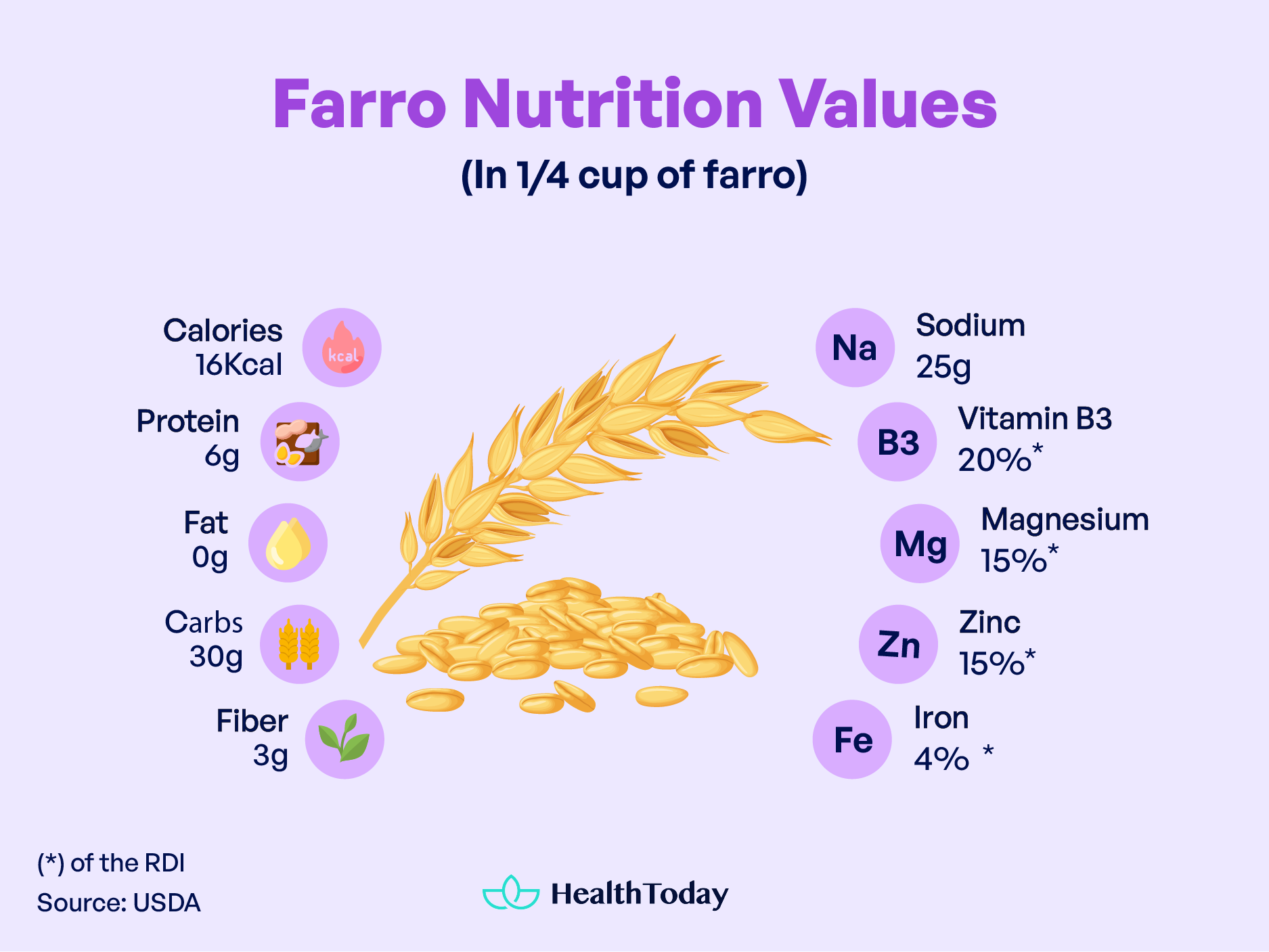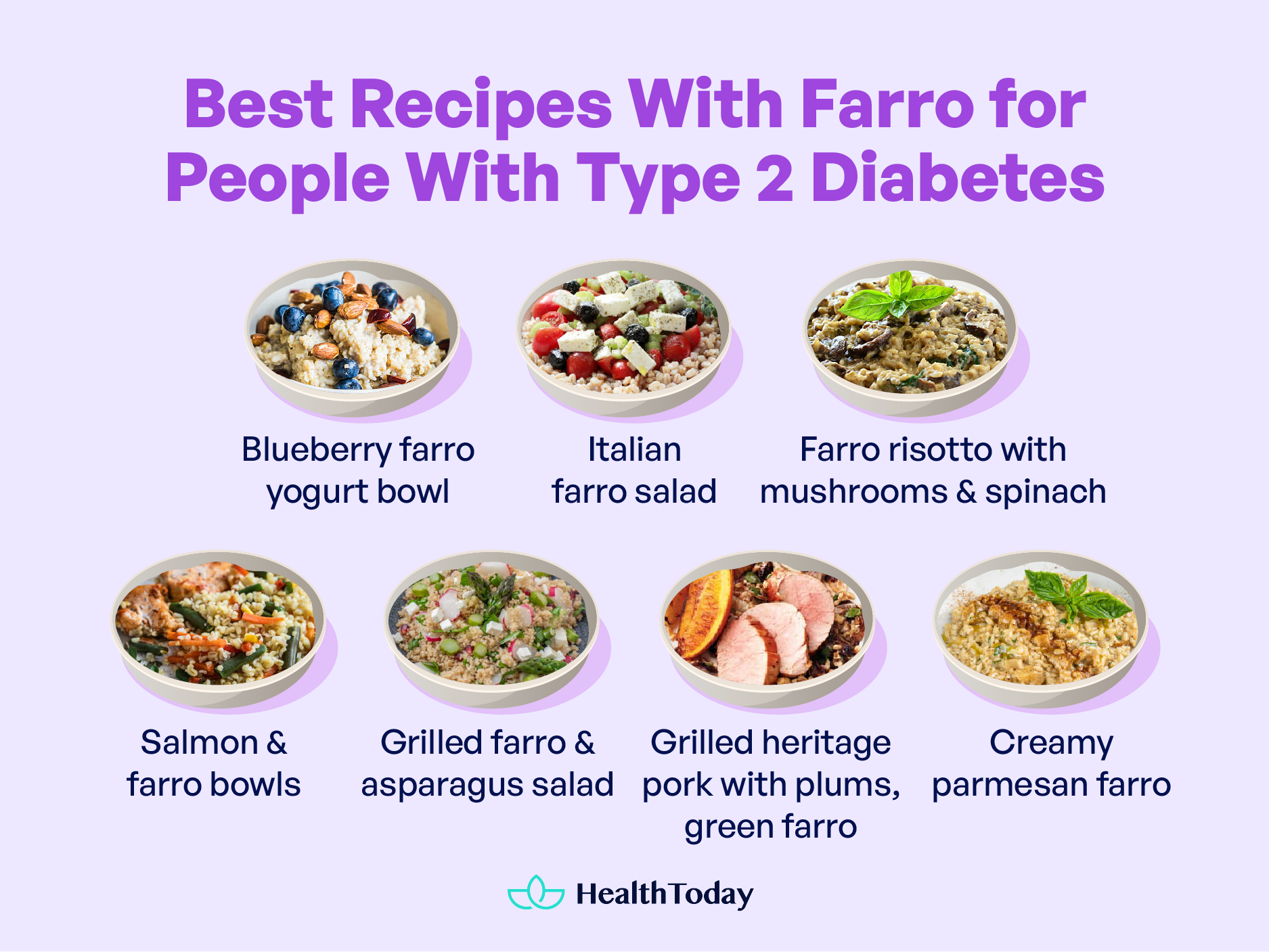Table of Contents
Farro is an ancient cereal that dates back to the time of the pharaohs and stands out because of its great nutritional profile. It’s an outstanding source of protein, antioxidants, and fiber—a superfood for everyone and those managing diabetes.
In this article, we will explore what farro is, its origins, and its health benefits. Moreover, we also provide some delicious and healthy recipes that you can add to your daily diet.
All about farro: Origin and nutrition facts
Farro (Triticum dicoccum) emerges as one of the primary grains in history and is considered the first type of wheat cultivated by man more than 12,000 years ago in Egypt.
In ancient Greece and Rome, farro is the main ingredient in making bread, as the Italian term “farina” means flour. However, its consumption was mainly reserved for the wealthy, while less fortunate people had to make bread with rye.
Over time, the cultivation of this grain spread throughout Europe and Asia, contributing to its rooting in various cultures over the centuries.
Nutrients per serving
According to the United States Department of Agriculture, in ¼ cup serving of farro, you are getting (1):
- Calories: 140
- Protein: 6 grams
- Carbohydrates: 30 grams
- Fiber: 3 grams
- Fatty acids, total trans 0 grams
- Sodium: 25 milligrams
- Vitamin B3 (niacin): 20% of the RDI
- Magnesium: 15% of the RDI
- Zinc: 15% of the RDI
- Iron: 4% of the RDI

Properties and benefits of farro
Farro has been consumed by different cultures throughout history and was positioned as an outstanding option compared to other grains, even better than oats.
Rich in protein and antioxidants
Farro has a remarkable protein concentration that varies between 11.2% and 22.7% per 100 grams, while other grains, such as rice, contain only 2.74 grams of protein in the same amount.
In addition, it contains multiple antioxidants, with notable polyphenols and carotenoids, making it a very useful food for protection against cell-damaging free radicals (2, 3). However, it is important to note that it is not suitable for people with gluten intolerance or celiac disease due to its 12.7% protein content in the form of gluten.
Quality carbohydrates and fiber
Quality carbohydrates are complex carbohydrates with a low glycemic index (below 55). The glycemic of foods is usually classified from 0 to 100 according to how quickly they increase blood sugar levels after ingestion. Farro has complex carbohydrates, which are digested and absorbed slowly in the digestive tract, resulting in a gradual and more sustained rise in blood glucose levels (4).
Foods with a low glycemic index are suitable for people who need to regulate their blood sugar, such as people with diabetes (5).
The fiber contained in farro is soluble and insoluble. Soluble fiber dissolves in water and forms a gel. In contrast, insoluble fiber does not dissolve and adds bulk to the stool, helping to move through the digestive system and preventing constipation. Soluble fiber also regulates food absorption, contributing to blood sugar regulation (6).
Low in unhealthy fats
With a remarkably low-fat content of between 1.14% and 3.8% per 100 grams, farro is known for its healthy fats, such as oleic and linoleic fatty acids, essential for the proper functioning of the body. These fatty acids are beneficial for cardiovascular health, as they reduce LDL-cholesterol (bad cholesterol) and increase HDL-cholesterol (good cholesterol), preventing diseases such as heart attacks, stroke, and arterial disease, among others (7).
Amino acids for muscle development
Farro contains a significant contribution of essential amino acids such as isoleucine, leucine, lysine, methionine, and phenylalanine. These enhance muscle development and boost protein synthesis (8), which is very important for athletes and people seeking to improve their physical performance.
In addition, some essential amino acids, such as phenylalanine, are precursors of neurotransmitters essential for mood regulation and cognitive function. Thus, the consumption of this grain may help to reduce the risk of cognitive diseases (9).
Rich in minerals and vitamins for health
Farro is rich in essential vitamins and minerals that contribute to overall health. It is a rich source of vitamin B3 (niacin), known for regulating cholesterol levels (10).
In addition, farro contains zinc, a vital component of a strong immune system.
Magnesium in farro influences muscle and nerve function positively. Some studies suggest that magnesium may help in blood pressure control (11). Besides, farro provides a small amount of iron, essential for producing hemoglobin (12).
We can place farro as a superfood due to its great nutritional profile, with abundant fiber, proteins, antioxidants, minerals, and vitamins. Besides, farrow has a low glycemic index thanks to its complex carbohydrates.
This ancient grain promotes cardiovascular and gastrointestinal health, muscle development, and cognitive function. It is also beneficial for the prevention of diseases such as diabetes, obesity, arteriopathies, strokes, and heart attacks. Incorporating farro into daily meals is a good way to improve your health.
Why is farro good for diabetes management?
Farro is a cereal that contains an excellent source of complex carbohydrates. It’s suitable for people who are overweight and/or have type 2 diabetes for many following reasons (13) (14):
- Low glycemic index: Farro has a low glycemic index (55 or less), which minimizes blood glucose spikes compared to high glycemic index foods (70 or more), like potatoes or jasmine rice. This makes it a healthier choice in the diet of people with type 2 diabetes, as it promotes stable glucose levels over time. However, portion size is always important for foods that contain an appreciable amount of carbohydrates, so eating ½ serving size may be the best choice if you are counting carbs.
- High fiber content: Farro is an ideal source of dietary fiber, which is beneficial for individuals with diabetes, constipation problems, and those seeking to control their weight. Fiber generates greater satiety, avoids eating frequently, and helps to reduce the absorption of sugars, thus avoiding blood sugar peaks and improving the sensitivity of cells to insulin.
- Advantages of whole grains: Since farro is a whole grain, it preserves the external coating, called bran, which contains most nutrients, such as fiber, vitamins, minerals, and antioxidants. Eating whole grains showed a significant decrease in the risk of type 2 diabetes, reducing it by 11% in men and 7% in women (15).
- Rich in minerals: Farro provides essential nutrients such as magnesium, which plays a key role in glucose metabolism and insulin action. Research suggests that magnesium deficiency may affect insulin secretion, increasing the risk of diabetes (16). Therefore, the consumption of farro may help to prevent this disease.
Best recipes with farro for people with type 2 diabetes
Farro is a nutritious whole grain that can be a good addition to the diet of people with diabetes, thanks to its multiple benefits and easy cooking. Here are some recipes that incorporate farro for people who need to consume low-glycemic foods:

Blueberry farro yogurt bowl
Start your mornings or enjoy snacks with this delicious and nutritious yogurt, farro, and blueberry recipe. It’s easy and quick, and with just a few ingredients, it can give you an incredible energy source to kick-start your day.
In a bowl, add half a cup of farro, a cup of Greek yogurt, a touch of vanilla extract, fresh blueberries, and a final touch with a pinch of ground cinnamon. Mix it all, sit back, and enjoy starting your day.
Italian farro salad
Are you short on time and want to eat something healthy, nutritious, and tasty? This easy-to-prepare farro summer salad with juicy, sweet cherry tomatoes, horseradish, feta cheese, aromatic herbs, and a spicy vinaigrette will make your day.
Cut the tomatoes and radishes into small cubes; put them in a bowl. Add the cheese, a pinch of herbs, and vinaigrette to taste. Mix and serve.
Farro risotto with mushrooms and spinach
Sauté mushrooms, onion, and garlic in a pan. Then add the farro and vegetable broth, allowing it to absorb the flavors. Finishing by adding fresh spinach and Parmesan cheese, creating a dish that will delight your palate with every bite.
Salmon and farro bowls
Start with a farro base and add your favorite vegetables, such as mini sweet peppers, radishes, cucumber, avocado, and carrots, then mix well. Place a grilled salmon fillet on top and finish with a drizzle of lemon vinaigrette.
Grilled farro and asparagus salad
This Grilled Farro and Asparagus Salad is highlighted by the whole grain farro base, which provides a nutty flavor and eight grams of fiber per serving. It is complemented with grilled asparagus, lemon zest, almonds, dill, scallions, and salty feta cheese for a blend of flavors and textures. Ideal as a vegetarian dish, this recipe also makes an excellent accompaniment to any grilled chicken preparation.
Grilled heritage pork with plums, green farro, and summer herbs
Grilled pork with plums, green farro, and summer herbs is a delicious twist that you should try. Green farro serves as a hearty base and is complemented by a blend of summer herbs for freshness.
This balanced combination promises a rich and satisfying dining experience.
Creamy parmesan farro
Creamy Farro Parmesan is a simple dish, in which farro is combined with broth, Italian cheeses, onion, garlic, butter, and parsley in a one-pot preparation. It is ideal for winter days when we need to raise our body temperature.
These recipes incorporate farro into delicious and easy-to-cook dishes to provide fiber, protein, vitamins, minerals, and antioxidants. However, you should tailor your diet to your needs. It is important to consult with a physician or nutritionist to develop a diet that works best for you.
What grain does not raise blood sugar?
Farro is a grain with a low glycemic index, making it a good choice for those looking to manage blood sugar levels.
What is the downside of farro?
The downside of farro is that, like many whole grains, it contains gluten, which may not be suitable for individuals with gluten sensitivity or celiac disease.
Which is healthier, farro or brown rice?
Farro and brown rice are both healthy, each offering unique nutritional benefits. Farro is higher in protein and specific nutrients, while brown rice is gluten-free.
Can you lose weight eating farro?
Farro can be part of a weight-loss-friendly diet due to its high fiber content, promoting satiety and aiding in weight management when consumed in moderation.
Summary
Farro is an exceptional ally in the diet of those seeking to take care of their health, including people with diabetes. This ancient whole grain cereal not only has a low glycemic index but also provides a rich combination of proteins, antioxidants, fiber, minerals, and essential vitamins.
Its versatility in the kitchen makes it an easy superfood to incorporate into our daily routine. In addition to being a diabetic-friendly option, farro is a valuable resource for promoting overall wellness and enjoying a balanced diet.

















Comments
0